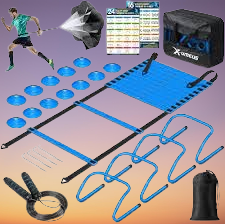Cardio King: Treadmill Workouts for Improved Endurance
Introduction to Treadmill Workouts
Treadmill workouts have long been hailed as a cornerstone of cardio exercise, offering a multitude of benefits for fitness enthusiasts. Among these, Cardio King stands out as a versatile and effective method for enhancing endurance levels.
Endurance is an important component of overall fitness, and an effective way to increase it is through treadmill workouts. Whether you're a seasoned runner or just starting your fitness journey, incorporating treadmill exercise can elevate your cardiovascular health. This article'll explore different treadmill workouts designed to increase your endurance and keep you in top shape.
Understanding Endurance and Its Importance
Endurance goes beyond physical stamina; it dictates our capacity to endure stress, fatigue, and prolonged exertion. In daily life, improved endurance translates to increased productivity, better mental focus, and enhanced overall well-being.
Why Choose Treadmill Workouts for Endurance?
The allure of treadmill workouts lies in their accessibility and controlled environment. Regardless of weather or time constraints, one can engage in tailored workouts to improve endurance consistently.
Designing an Effective Treadmill Workout Routine
Crafting an effective regimen involves a blend of warm-up exercises, interval training, and smart utilization of speed and incline variations. These elements challenge the body and gradually build endurance levels.
1. Interval Training:
Interval training is a powerhouse for improving endurance. Alternate between intense runs or sprints and slow recovery phases. For example, sprint for 1 minute, then walk or jog at a moderate pace for 2 minutes. Repeat this cycle for a challenging but effective workout.
2. Inline Challenge:
Elevating the incline of the treadmill adds an extra level of difficulty to your workout. Walking or running uphill engages different muscles and intensifies the cardiovascular demand. Start with a moderate incline and gradually increase it as your endurance increases.
3. Pyramid Run:
Start with a comfortable warm-up pace. Then, increase the speed incrementally every minute until you reach your maximum effort. After reaching the peak, slowly reduce the speed in the same manner. This pyramid-style workout challenges your endurance throughout the session.
4. Endurance Run:
Dedicate a day to long, steady-state runs. It helps build your aerobic capacity and mental resilience. Start at a pace that allows you to maintain a conversation, gradually increasing the duration as your fitness improves.
5. Fartlek Training:
Fartlek, Swedish for "speed play," varies your speed and intensity throughout the workout. Add in sporadic walking, jogging, and sprinting. It not only keeps the workout interesting but also effectively improves endurance.
6. Hill Sprint:
Incorporate short, intense sprints into your workouts. Set the treadmill to a challenging incline and sprint for 30 seconds, followed by a recovery period. Hill sprints increase both cardiovascular and muscular endurance.
7. Running backwards:
Engage different muscle groups by incorporating backward running intervals. It adds a unique challenge and helps improve balance and coordination. Start at a slow pace and gradually increase as you become more comfortable.
8. Tempo Run:
Maintain a challenging but sustainable pace for an extended period. Tempo runs raise your lactate threshold, delaying the onset of fatigue. Aim for speeds outside of your comfort zone for the duration of the workout.
Nutrition and hydration for endurance
Proper nutrition and hydration are crucial for endurance athletes to perform at their best and recover effectively. Here are some key considerations for both:
Nutrition:
Carbohydrates: These are the primary fuels for endurance activity. Eat a diet rich in complex carbohydrates, such as those found in fruits, vegetables, and whole grains. For each kilogram of body weight, aim for approximately 3–7 grams of carbohydrates, depending on the length and intensity of your training.
Protein: necessary for the recovery and repair of muscles. Add sources of lean protein like fish, poultry, beans, and legumes. Aim for 1.2 to 2.0 grams of protein per kilogram of body weight per day.
Fats: Offer an additional energy source for prolonged physical activity. Add in healthy fats from nuts, seeds, avocados, and olive oil, among other sources.
Hydration: Proper fluid balance is crucial for endurance performance.
Hydration:
Pre-hydration: Make sure you are well-hydrated before starting your exercise. Drink about 500 ml of water 2-3 hours before and another 250 ml 20–30 minutes before.
When exercising: Make sure you are getting enough fluids—roughly 150–300 milliliters every 15-20 minutes. For longer events, consider sports drinks to replenish electrolytes lost through sweat.
Post-exercise: Rehydrate with water or a recovery drink containing electrolytes. Aim to replace fluids lost during exercise within two hours.
Electrolytes: You might need to replenish electrolytes like sodium, potassium, and magnesium if you exercise for an extended period of time, especially in hot weather. This can be through sports drinks or electrolyte supplements.
Remember, individual hydration and nutritional needs can vary, so it's essential to experiment with training to find what works best for you. Consult a sports nutritionist for personalized advice based on your specific needs and training regimen.
Pre-workout nutrition
Pre-workout nutrition is crucial to providing the energy needed to optimize your performance during exercise. Here are some guidelines for effective pre-workout nutrition:
Meal Time: Eat a well-balanced meal 2-3 hours before your workout. There should be a balance of fats, proteins, and carbohydrates in these meals.
Snack timing: If you're eating close to your workout, choose a small snack about 30–60 minutes before, focusing on easily digestible carbohydrates and a moderate amount of protein.
Pre-Workout Nutrients:
Carbohydrates: These are the body's primary source of energy. Choose complex carbohydrates like whole grains, fruits, and vegetables. Carbohydrates help replenish glycogen stores, providing sustained energy. Aim for 1-2 grams of carbohydrates per kilogram of body weight.
Protein: Include a moderate amount of protein in your pre-workout meal or snack to support muscle maintenance and repair. Sources like lean meat, dairy, or plant-based protein are excellent choices.
Fats: While moderate amounts of healthy fats are acceptable, focus more on easily digestible options to avoid discomfort during exercise. Nuts, seeds, or a small amount of avocado can be good choices.
Hydration: Make sure you are well-hydrated before your workout. Dehydration can negatively affect performance. Try to have a 500 ml or so drink two to three hours before working out, and another 250 ml to half an hour before.
Sample Pre-Workout Meals:
A. 2-3 hours before:
* Fried chicken breast
* Quinoa
* mixed vegetables
* Drizzle with olive oil
B. 30-60 minutes before:
* Greek yogurt with a handful of berries
* Whole grain toast with nut butter
Tips for Maximizing Endurance Gains
Consistency remains paramount in endurance training. Regular assessment of progress and adjustments to the workout routine ensure steady improvements without overexertion.
Common Mistakes to Avoid
Overtraining and neglecting rest can hinder progress and lead to injury. It's crucial to strike a balance between pushing boundaries and allowing the body adequate recovery time.
The Psychological Aspect of Endurance Training
Building mental stamina is as crucial as physical endurance. Overcoming plateaus and challenges contributes significantly to overall endurance gains.
Nutrition and Hydration for Endurance
A well-balanced diet and proper hydration are fundamental for sustaining energy levels during workouts and aiding in recovery.
Case Studies and Success Stories
Real-life examples highlight the transformative power of consistent treadmill workouts, showcasing improved endurance and overall fitness.
Conclusion
Cardio King's treadmill workouts offer an accessible and effective means of boosting endurance. Whether starting a fitness journey or aiming for higher fitness levels, these workouts pave the way for enhanced endurance and overall well-being.
FAQs:
1. How often should I do treadmill workouts for endurance?
The frequency depends on your fitness level, but aiming for at least 3-4 sessions per week is a good start.
2. Can I solely rely on treadmill workouts for overall fitness?
While treadmill workouts are beneficial, a well-rounded fitness routine including strength training and flexibility exercises is ideal.
3. What should I eat before a treadmill workout for better endurance?
Opt for a light meal or snack rich in carbohydrates and moderate in protein about 30-60 minutes before your session.
4. Are there specific age restrictions for treadmill workouts?
It's advisable to consult a healthcare professional before starting any new exercise routine, especially for individuals with underlying health conditions.
5. How long does it take to notice improvements in endurance with treadmill workouts?
Individual progress varies, but noticeable improvements often start within a few weeks of consistent training.


.jpeg)

.jpeg)




.webp)

